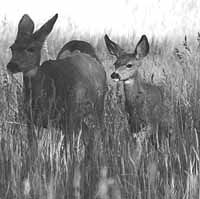| Deer will be more plentiful in some places this year, less in others. |
For the first time in years, rifle hunters in the northern half of Utah may see as many deer as those hunting in the south.
Utah’s general rifle buck deer hunt begins Oct. 23. About 60,000 hunters are expected afield for the state’s most popular hunt.
Permits for four of Utah’s five regions have sold out, but at the start of October about 6,000 Northern Region permits were still available. Permits may be purchased at the Division of Wildlife Resources’ Web site (wildlife.utah.gov), from 170 license agents statewide and the DWR’s six offices.
“The northern half of Utah received some good rainfall during the spring of 2003, and that helped the number of fawns born that spring rebound after four years of decline,” said Jim Karpowitz, big game coordinator for the Division of Wildlife Resources. “Few deer were lost this past winter, so most of the male deer born in spring 2003 will be available as spike and two-point bucks this year.”
While deer herds in the northern part of Utah are doing better, deer in the southern parts of both the Southern and Southeastern regions continue to struggle because of drought. As a result, buck to doe ratios are almost identical across the state. “All of the five regions are about the same as far as buck to doe ratios, with an average of 15 to 16 bucks per 100 does across Utah,” he said.
Karpowitz says the moisture received this spring and summer has provided a lot of green vegetation. “Wet weather tends to spread deer out more, which can make it harder to locate them,” he said. “If snow falls between now and the hunt, the deer will move lower in elevation and will be concentrated a little more. If we don’t receive some snow, the deer will stay at higher elevations and will be spread out.”
Karpowitz says deer are traditional in their habits and movements. Because of this, hunters who hunt the same area each year are usually the most successful. “If you’ll be hunting a new area this year, it’s vital that you get out and scout the area ahead of time,” he said.
Karpowitz also encourages rifle hunters to prepare for all types of weather. “While it hasn’t happened for awhile, it’s not that unusual to receive a lot of snow during the rifle hunt,” he said. “Make sure you have tire chains and the type of equipment needed to hunt in winter-type conditions.”
He also encourages hunters to obtain off-highway vehicle travel maps before heading afield. The maps show where OHVs can and can’t be used. They may be obtained from the agency � usually the U.S. Forest Service or the Bureau of Land Management � that manages the land you’ll be hunting.
Bill Bates, Southeastern Region wildlife manager, says deer hunting in southeastern Utah will be a “mixed bag” in 2004.
“Buck-doe ratios are pretty close to the management objective of 15 bucks per 100 does,” Bates said. “The Manti unit is slightly higher at 17 bucks per 100 does. The LaSal and Abajo mountains stand at 13 bucks per 100 does.”
Region-wide, the deer population remains at about 56 percent of herd objective. The Book Cliffs have the most room for growth, with herds at 25 percent of objective. The Manti, at 75 percent, takes the lead deer herd recovery. Other units fall in at about 50 percent.
“Fawn to doe ratios increased this year and averaged 54 fawns per 100 does,” Bates said. “This number is up significantly from previous years, but still has a long way to go. Doe to fawn ratios higher than 70 fawns per 100 does are desirable for the population to recover.”
Bates says rifle hunters can expect to see a lot of yearling bucks this year. “This past winter caused very little winterkill because periods of moisture were broken by periods of melting, making forage available to the deer,” he said.
Bates urges hunters to do some pre-season scouting. “Scope and glass good deer habitat from ridge tops in the early morning or late evening,” he said. “After locating bucks, try to pattern their daily habits and movements. Realize, however, that the behavior patterns of deer may change dramatically with increased hunter traffic.”
For more information, call (435) 636-0260.

